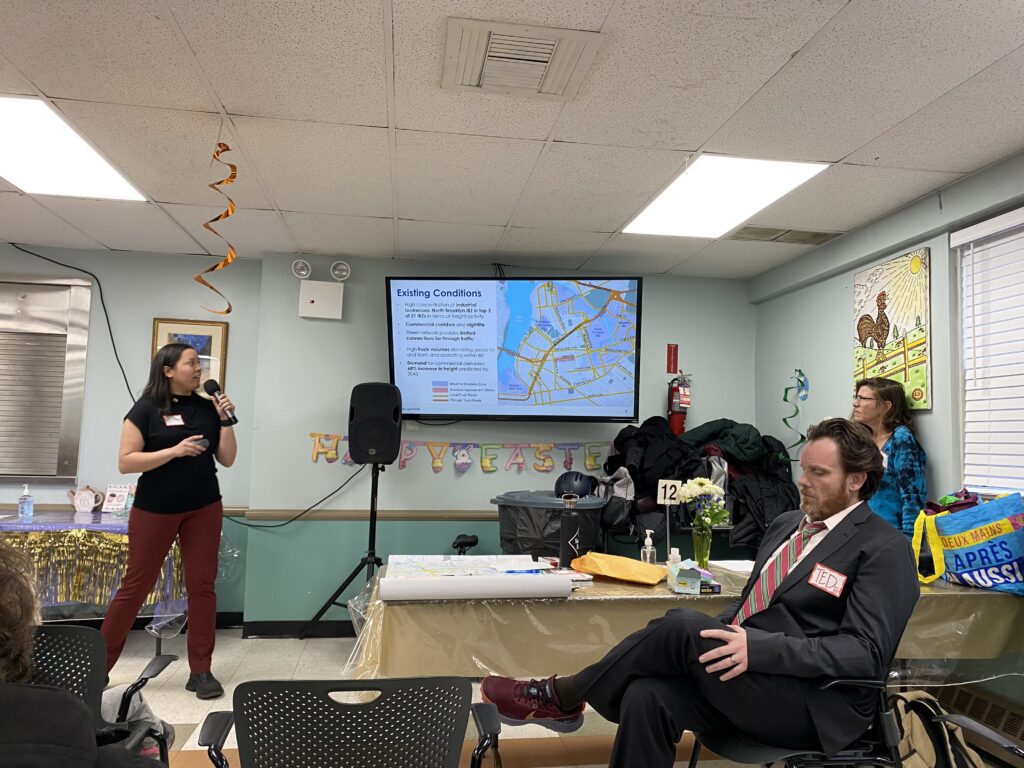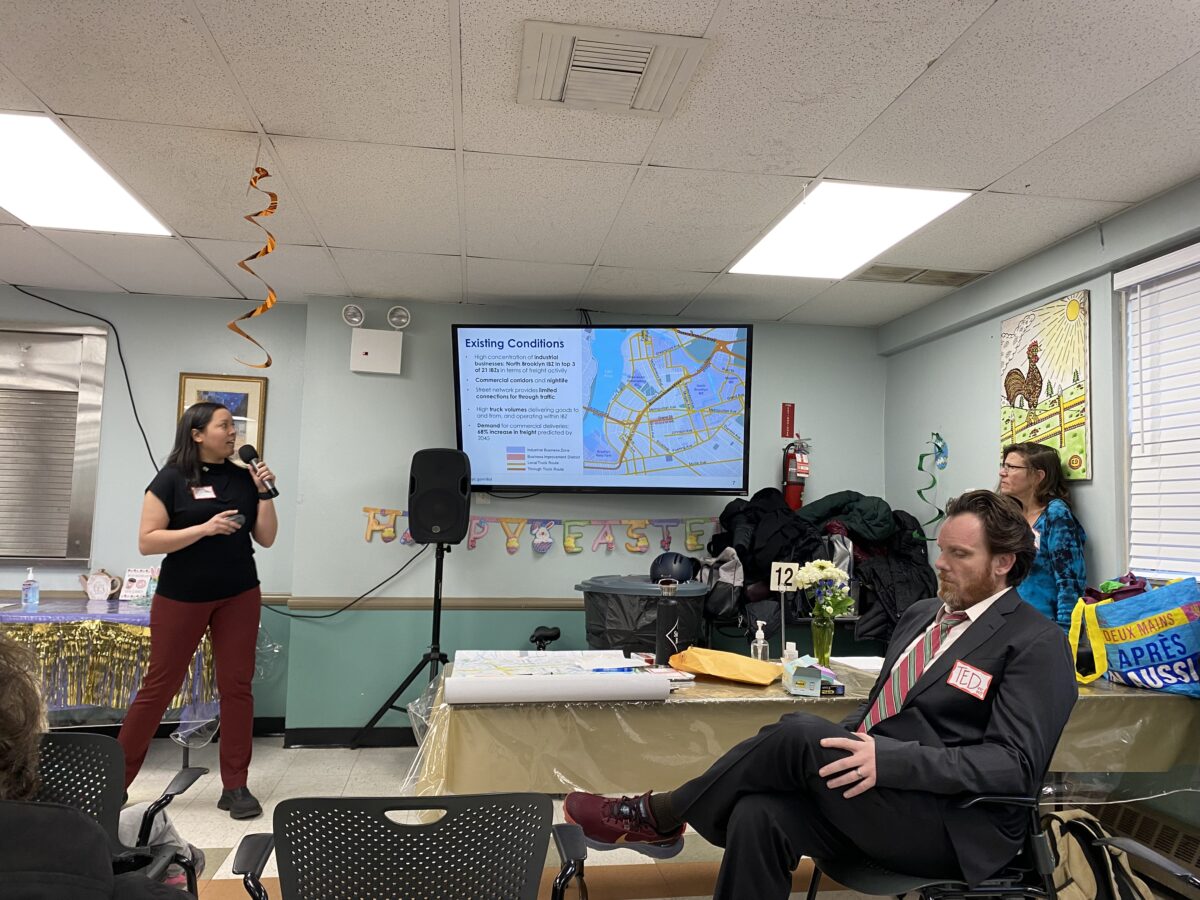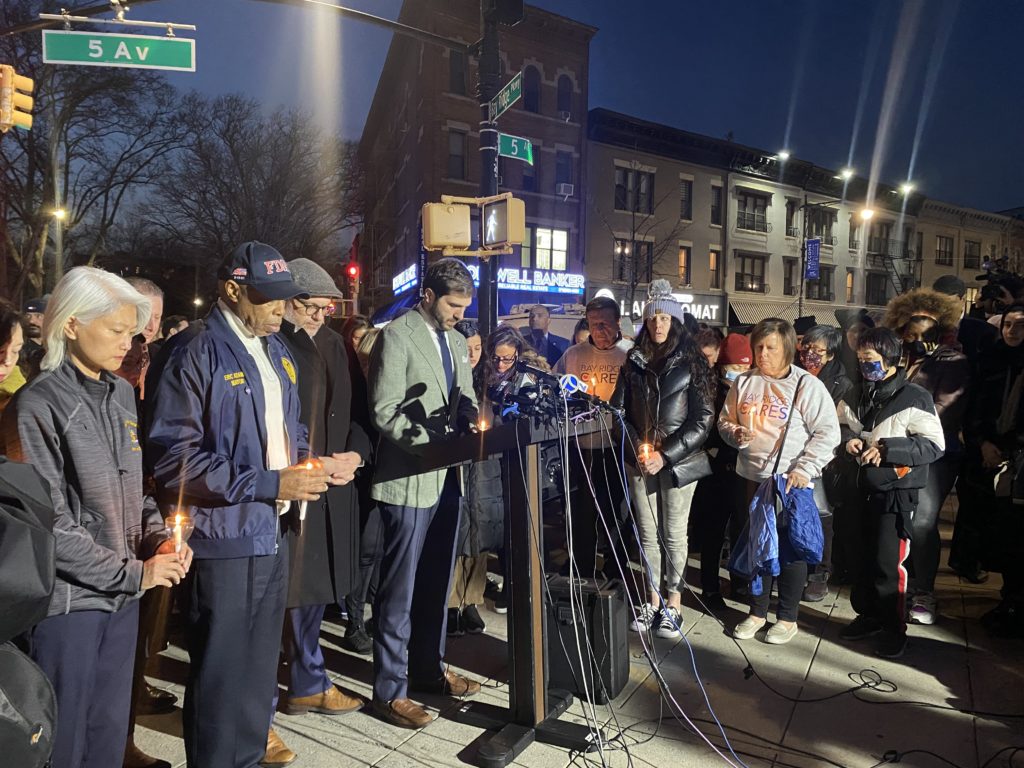DOT Hosts Redesign Workshop for North BK Streets

A Department of Transportation representative facilitated the discussion in each group and answered logistical questions that arose.
By Iryna Shkurhan | ishkurhan@queensledger.com
With stickers, markers and post-its in hand, North Brooklyn residents set out to redesign some of the most widely used, and problematic, corridors in their neighborhood.
The Department of Transportation (DOT) hosted the revisioning event on Thursday evening at the Swinging Sixties Senior Center on Ainslie Street. With over a hundred community members in attendance, no seat was left empty. The strong turnout and vocal attendees reflected the desire for a long awaited redesign that prioritizes safety and accessibility in the community.
The conversation centered around three main roadways — Grand Street, Metropolitan Avenue and Morgan Avenue — which are heavily utilized by pedestrians, cars, bus commuters, bicyclists and trucks on a daily basis. The event directly showed that accommodating everyone’s interests is tricky, with several possible solutions to consider.
A presentation by Lauren Rennée, a DOT project manager, outlined the changes implemented at these three locations over the past decade to address usability, especially for the growing number of cyclists. A “toolbox” of possibilities to address the issues that remain included one-way car conversion, removing a lane of parking, reducing travel lanes and sheltering bike lanes with either parking or jersey barriers.
The area that encompasses Williamsburg and Greenpoint ranks in the top-third of high-crash corridors in Brooklyn, according to the DOT. On Grand Street, 22 people were seriously injured between 2016 and 2020. Since 2016, there have also been seven fatalities. The crash rates were only slightly lower on Metropolitan Ave and Morgan Ave.
“There are a lot of challenges with the current design,” said Jennifer Gutiérrez, Council Member of District 34 representing Bushwick and Williamsburg, in her opening remarks. “We’re also here because there have been very real collisions and deaths along these corridors. Our goal before anything is to prevent all of those deaths.”
The central complaint of the evening was that the majority of the time, the bike lanes in all three locations were unusable due to parked cars or trucks blocking them. With poor access and visibility, bicyclists are forced to either disturb pedestrians on the sidewalks or put themselves at risk by riding into car designated lanes. But some business owners countered that bike lanes pose curb access challenges for deliveries and limited parking for visitors.
“I bike on Grand St and it’s very problematic, depending on which way you’re going,” said Francesca Romana Caputo, a Williamsburg resident. “There is always something parked on the bike lane.”
Attendees were seperated into a dozen breakout groups where they spent 45 minutes discussing possibilities for solutions with a map of the area open between them. Using color coded stickers, they marked problematic areas with a corresponding note.
Each group had a DOT representative to guide the conversation, offer their expertise while another representative diligently took notes of popular solutions. It was suggested 15 minutes of discussion is allotted to each corridor, but Metropolitan Ave received the most attention, and complaints.
“We want to design streets that enforce themselves,” said Preston Johnson, a DOT Project Manager who led the discussion in one of the groups.
Metropolitan Ave’s current design bans parking on the peak direction side during rush hour west of the Metropolitan Ave Bridge. And over 1,700 vehicles cross that bridge during the morning rush, according to DOT data. And east of the bridge, the wider section of the road is separated by a median with just a standard bike lane in place.

A Department of Transportation representative delivered a presentation on the issues affecting all three corridors.
Cyclists are growing at a fast rate in the city and are a central population that will be considered in the redesign. According to DOT data, 1.8 million Citi bike trips originated in Brooklyn’s Community Board 1 in 2022, not including personal bikes. It is also the most environmentally friendly mode of transportation.
A popular solution was to implement protected bike lanes that provide a safer dedicated space for cyclists. According to the DOT it is the “most appropriate treatment in areas with commercial and industrial activity.” Pedestrian injuries decreased by 21 percent and motor vehicle occupant injuries went down by 15 percent when protected bike lanes were introduced.
Grand St, which connects western Queens and Bushwick to Brooklyn and Manhattan via bridges and the BQE, generates high truck volumes and loading demand by serving commercial and industrial areas. Much progress has been made since 2008, when travel lanes had no separation or designation for bike riders. The following year, standard bike lanes were added and in 2018 they became parking protected curbside bike lanes. Last year, jersey barrier protection was also added.
Some bus riders complained that buses are forced to operate at slower speeds due to traffic, which leads to longer commute times for riders. They also complained that there is no enforcement of people illegally parking on bike lanes or blocking bus stops and lanes.
High truck rates stem from North Brooklyn being a hub for Industrial Business Zones. On Grand St, a lack of designated loading zones for trucks is a strong contributor to blocked bike lanes.
Many attendees proposed converting one or more of the three corridors into one-way roads to create more space for bike lanes and reduce congestion created by cars and trucks. Some attendees worried that by redesigning a large street as a one-way, smaller side streets that are currently favorable to biking will receive an influx of truck traffic.
Morgan Ave is one of the few north-south streets in Williamsburg that intersects Grand St and Metropolitan Ave. While a curbside bike lane was installed from Grand St to Grattan St in 2018, there is currently a bike network gap north of Grand St to Meeker Ave, Queens via the Kosciuszko and Pulaski Bridges.
Physically narrower roadways, one example of self-enforcing design, tend to discourage speeding that is present in wider roadways. They will also shorten crossing distances for pedestrians, a significant challenge for seniors.
Seniors make up less than 15 percent of the city’s population but over 45 percent of pedestrian fatalities. And 90 percent of senior and non-senior adult injuries occur at intersections. A proposed solution with seniors in mind is to include a halfway pedestrian island to split up intersection crossing into two parts.
”The other thing that no one has mentioned during this presentation is the pollution,” said Caputo, who lives directly on Grand St. She said that every morning a thick layer of black residue accumulates on the windowsill in her bedroom. “It’s insane. This is what we’re breathing everyday.”
The DOT plans to unveil their redesign proposal, created with resident suggestions in mind, at an upcoming Community Board 1 meeting.




